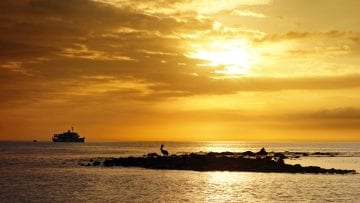Time difference
It is one hour earlier in the Galápagos Islands than in mainland Ecuador. In comparison to mainland Europe, there is an eight-hour time difference during summer time and it is seven hours earlier during our winter time.
In the Pacific Ocean an extraordinary world awaits
“We are like islands in the sea, separate on the surface but connected in the deep.” – William James –
How long have you been dreaming about your Galápagos adventure? Was it since your read the history of Darwin, who began to develop his theory of evolution on board the Beagle? Are you inspired by beautiful nature documentaries? Have you listened to exciting stories from friends or family who can’t stop talking about their Galápagos experiences?
The deep emotions of actually being there cannot be translated into images nor words. A visit to this unique place is an experience beyond imagination. Rare birds are within close reach, you will stand face to face with prehistoric iguanas or walk besides a penguin. Snorkelling among turtles gliding gracefully through the water and the indescribable joy of watching sea lions or dolphins play. Experience what it means to genuinely be at one with nature.
Even more important than the volcanic landscape are the waters that surround the Archipelago. The islands are located in a very special place. Three major oceanic currents influence marine life. The Humboldt (cold and rich in nutrients), the Panama (warm water that allows for coral to grow) and the Cromwell (a cold current, especially around the central islands). The geological base of the islands is around 900 meters below sea level, while the ocean around the archipelago is almost 3,500 meters in depth. This unique combination of currents, nutrients and shallow ocean water is the perfect habitat for marine life. Both on land and in the water, you will be mesmerised by the wealth of (endemic) wildlife.
“A total of 80% of the birds and 97% of the reptiles found in the archipelago are endemic to this area!”
Once arrived at the archipelago, these animals adapted to their new environment. Due to the great distance from the mainland and between the islands themselves, they were able to evolve independently of their peers. This is how the many endemic species developed that make the Galápagos such a unique destination.
The marine iguana is a wonderful example of a species endemic to the Galápagos. Their peers in Latin America live in trees, eat plants and rarely swim. Once they arrived on the islands they learned how to swim and stay under water for long periods of time to feed on algae.
The Galápagos Cormorant has also undergone a fascinating development. In its new environment there was more than enough food available and there were no natural enemies. The bird no longer needed to stretch its wings in order to survive and hence lost its ability to fly.
The islands proved to be a perfect retreat and resting place after months on the high seas, with very negative consequences for animal life. Whales were caught in large numbers for their precious whale oil, which in the 19th century was seen as an excellent source of fuel. The giant tortoises were stored by thousands on the ships below deck. Tortoises can survive up to a year without fresh food nor water and were therefore a nutritious ingredient for a fresh meal during the voyage.
The 19th century also brought the Galápagos its most famous visitor, Charles Darwin. Darwin arrived aboard the HMS Beagle in September 1835 as he sailed through South America to discover unknown territories. Unfortunately, he didn’t have much time to explore the Islas Encantadas. He spent about five weeks studying the geology and biology of four islands: Floreana, Santiago, San Cristóbal and Isabela. Partly as a result of his findings during this visit, Darwin developed his ideas when he returned home, which laid the foundation for the theory of evolution.
Since 1959, the islands have been a national park. The Charles Darwin Foundation was founded that same year to safeguard the conservation of the flora and fauna of Galápagos. The oceans surrounding the archipelago have also been declared as a protected marine reserve. The islands have been on the UNESCO World Heritage List since 1978 and this was expanded with the marine reserve in 1981. Today, the Galápagos Islands have around 25,000 inhabitants; only 3% of the Galápagos Archipelago is inhabited, with the largest population living in Puerto Ayora, Santa Cuz (around 10,000).
The islands are a great destination year-round. Although there are small differences in the weather, every time of year is pleasant.
Due to its location at the equator, the climate is mostly dry and warm and is considered “tropical”. The archipelago lies in the transition zone of two sea currents, the cold Humboldt from Antarctica and the relatively warm sea current from the Gulf of Panama, driven by El Niño.
“The islands are a great destination year-round.”
From December to May the influence of the warm current from the north is dominant creating for what is known as the wet season. This however mostly means occasional short showers at the end of the day or at night; mostly the sun will out. The average temperature is 20˚C to 32˚C, the water temperature is very pleasant from 21˚C to 26˚C.
The period June to November is influenced by the cold current from the south, it is less hot and sometimes cloudy and somewhat foggy, especially in the morning and in the highlands. In the Galápagos this period is known as “garúa” which means” fog “. You can expect an average temperature of 15˚C to 25˚C and the water temperature varies between 18˚C and 24˚C.
You will not find any prices on our website. This is a conscious decision.. A vacation on the Galápagos Islands can vary enormously in cost, depending on the choices you make. All our trips are tailor-made. Our goal is to create the best possible experience within your budget, which is different for everyone.
To give you an idea, there are some fixed costs that you have to take into account: the return flight between mainland Ecuador and Galapagos (€550- €650 pp), the National Park Fee ($100 pp) and the Tarjeta de Control de Tránsito ($20 pp).
The price of a good expedition cruise starts at around €600 per person per day for a middle class ship; for a cruise on a luxury yacht or catamaran you have to take into account approximately €900 per person per day, this can go up to more than €1,000 for the most luxurious boats. Cruises from 4 days are possible, although we advise you to go for a longer period of time.
Island Hopping is possible on a smaller budget and provides a different holiday experience. Contact us so that we can discuss your wishes and explore your options!
“Imagine what your journey of a lifetime would look like”
The holidays on our website are here to inspire. Read the stories, enjoy the photos and start dreaming at the thought of what your ideal trip would look like. We are happy to help you to properly chart your ideas and wishes. By listening to your wants and needs, we will create the journey of your dreams. We curate tailor-made, truly individual travel experiences to your heart’s desire.
This voyage combines one of the best possible itineraries with by far the most elegant ship in the Galápagos Islands. You visit spectacular locations aboard a historic yacht; a journey that touches the soul.
Go back in time aboard an iconic barquentine and visit the ages of pirates and whalers. Discover the Galápagos in all its facets: animal life, fauna, volcanic landscapes and human history. This 360° perspective of the Galápagos Archipelago will make your stay impressive and comprehensive.
A somewhat smaller ship, a somewhat shorter itinerary. Adventurous with great visitor sites! During this trip you will visit some of the best snorkelling areas in the Archipelago.
Would you prefer to stay in hotels instead of on a ship? Then island hopping is the best for you! During this 10-day holiday you will stay in a hotel of your choice (from budget to luxury is possible) on 3 different islands. You cross from island to island by plane, quickly and comfortably. In addition, we have chosen the most beautiful day trips for you, so that you can spot all the unique wildlife on the islands.

It is one hour earlier in the Galápagos Islands than in mainland Ecuador. In comparison to mainland Europe, there is an eight-hour time difference during summer time and it is seven hours earlier during our winter time.

You do not need a visa to travel to the Galápagos. You do, however, have to purchase a Transit Control Card upon departure from the airports of Guayaquil or Quito and you pay the National Park Entrance Fee upon arrival on the islands. Your passport must be valid for 6 months upon arrival.

The currency in Ecuador and the Galápagos Islands is the US Dollar. Credit cards are generally accepted. However, you should keep in mind that on the islands many things are still paid in cash. Good cash machines can be found in the most important places.